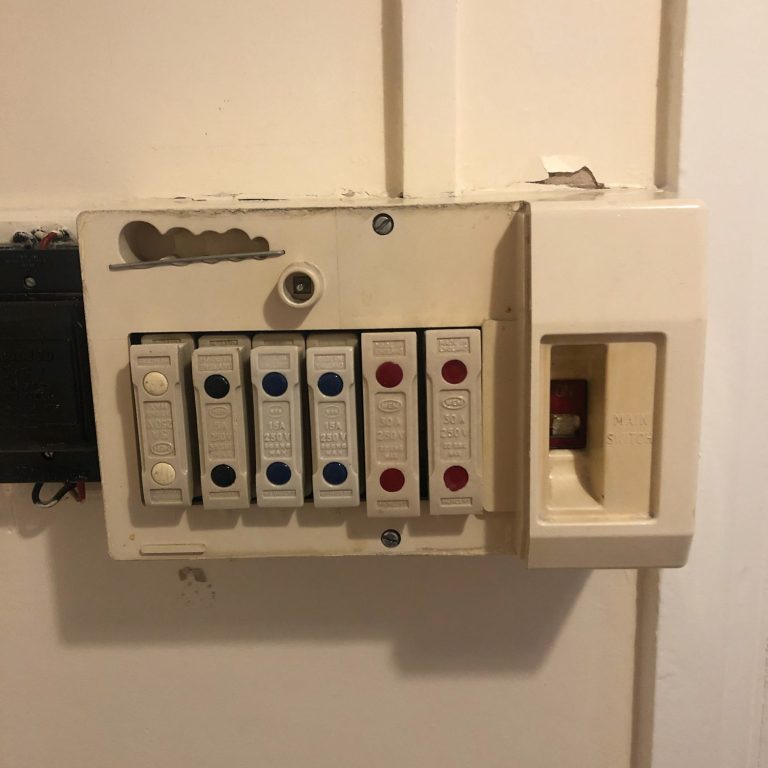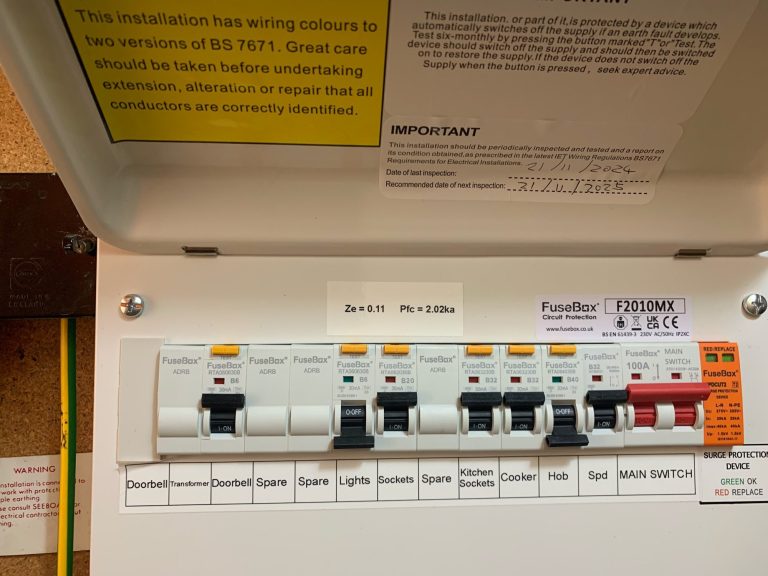Consumer Units

Ceramic rewirable fuse box
Ceramic rewirable was common before the 1950's

Rewirable fuse box
Cartridge fuses were popular from the 1950's to 1980's

And a general mess!!
KEY INDICATORS FOR REPLACEMENT
1. YOUR CONSUMER UNIT IS OUTDATED
Age is one of the most tell-tale indicators of when to replace your consumer unit. Old units, especially those in place before 1990, do not have modern safety features such as Residual Current Devices (RCDs) and Miniature Circuit Breakers (MCBs). Instead, they rely mainly on fuses and do not provide much protection against electrical faults compared to newer systems that use RCDs, which are more effective.
Signs Of An Outdated Unit
- The unit uses re-wirable fuses, which are less reliable and prone to user error.
- There is a lack of RCD protection, which is essential for safety.
- The absence of circuit labelling makes it difficult to identify the areas of the home that each circuit supplies.
Suppose the age of your consumer unit is more than 30 years. In that case, consider asking a professional electrician about replacing a consumer unit and whether there is a need for an update.
2. FREQUENT TRIPPING OF CIRCUIT BREAKERS
It should be noted that weak breakers will go down more often than stronger ones because they can detect more little faults. Frequent breakage of your circuit breaker is an early sign indicating something is wrong with your consumer unit.
If your fuse keeps tripping, this could be a sign that you have an overloaded circuit or wrong wiring. In such cases, you should consult professional rewiring specialists to ensure your electrical system is safe and up to code.
Common Causes Of Frequent Tripping Include
- Overloaded circuits – Overloaded circuits might not be able to handle your home’s electrical load, especially if you’ve added new appliances or electrical extensions recently.
- Faulty wiring– Old or damaged wiring can cause repeated tripping as the unit attempts to prevent overheating or sparks.
If you notice your breaker constantly tripping, it’s a good idea to inspect your consumer unit with a professional to determine if a replacement is needed.
3. VISIBLE SIGNS OF WEAR OR DAMAGE
A simple visual inspection may show you if your consumer unit is no longer up to standard. The unit may not operate correctly or safely due to worn-out or damaged parts. It is time for a replacement if one notices any of the following:
- You may notice marks where the fuses are burned, or the colour might have changed from black to brown.
- A burning scent emanating from the unit can suggest overheating.
- Additionally, you might observe loose or corroded wires around the appliance.
- Signs of rust or water damage may also indicate moisture issues with the appliance.
These indicators suggest an electrical fault that can cause fire, thus necessitating prompt actions to ensure home safety.
4. NO RCD PROTECTION
The Residual Current Device (RCD) is one of the essential safety features of modern consumer units. This device automatically turns off the electricity supply when it detects a current leakage, which occurs when a live wire meets water or metal. RCD protection helps prevent electric shock and reduces the chances of fire caused by electricity.
On the other hand, if you do not have an RCD-protected consumer unit in your home, there is a risk that you might be exposed to electrical hazards, especially in places such as bathrooms, kitchens and outdoor sockets.
5. YOU’RE RENOVATING OR EXPANDING YOUR HOME
When renovating your home, putting up extra rooms or wanting to upgrade your electrical system by adding new appliances, you must check the capacity of your consumer unit to bear increased power consumption. Old units were designed for fewer electrical devices in homes and may need help to sustain the contemporary load.
Additionally, it’s essential to schedule electrical testing and inspection to verify that all updates meet safety standards.
6. NOISY CONSUMER UNIT
Your consumer unit should work in silence. Nevertheless, if you hear buzzing or humming noises from it, there is something wrong. Often, such sounds mean connections are loose, circuits are overloaded, or components are damaged within the unit.
If ignored over time, they can cause overheating, leading to electrical faults or fires. You need an electrician to check your noisy consumer unit. Otherwise, it will need replacing due to safety concerns.
7. PEACE OF MIND
Finally, one of the biggest reasons to replace an old or outdated consumer unit is knowing your home’s electrical system is safe and reliable. With a new, modern consumer unit, you’ll reduce the risk of electrical fires, shocks, and appliance damage, ensuring your family and property are well-protected. Additionally, consider the fuse box replacement cost as an investment in your home’s safety and functionality.



This consumer unit dated from the 1970's and offered nothing but basic protection and had to be rewired if there was a fault
Replaced with a modern consumer unit from the fusebox range
Now with an SPD for surge protection and RCBO's for additional protection. So much safer
©Copyright. All rights reserved.
We need your consent to load the translations
We use a third-party service to translate the website content that may collect data about your activity. Please review the details in the privacy policy and accept the service to view the translations.
